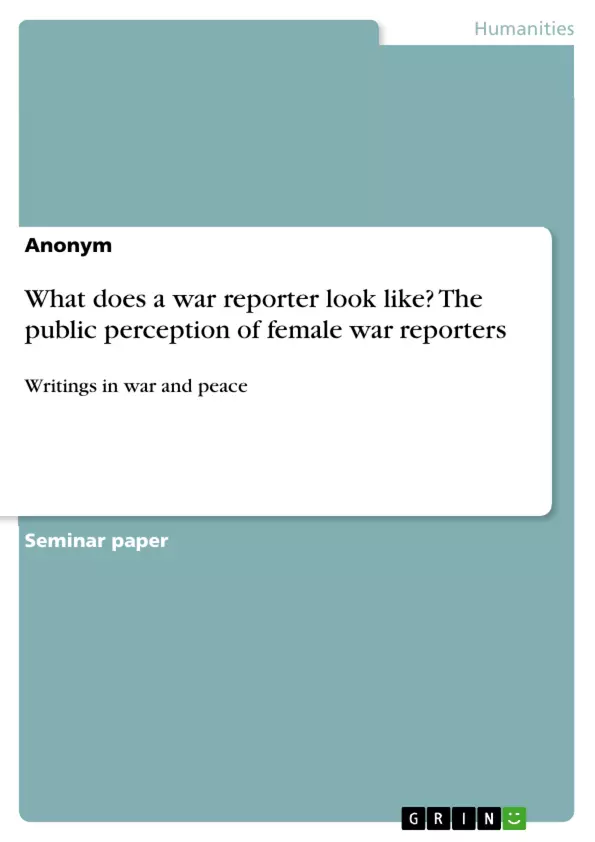Female war reporters are still underrepresented in western media, it is commonly assumed that the prototypical war reporter is a male correspondent. Thus, Korte assumed that the profession of embedded reporters is a world determined by men and in public’s perception war correspondents are still considered to be rather male than female. This paper points out how female war reporters are perceived by western society and interrogates whether Korte’s assumption represents reality or not.
This essay also examines in how far these representations correspond to existing public perceptions regarding female war reporters but also have repercussions for our conception of war correspondents. Since the late 19th century a particular public interest in war correspondents has grown. Today, attention has reached new heights due to public fascination with people who present and organize images of destruction and misery. Public interest in the profession of war correspondents derives from the fact that correspondents deal with socially relevant questions and help to shape people’s perception of war: they may thus be thought of as “essential contributors to the public understanding” of military conflicts.
Inhaltsverzeichnis (Table of Contents)
- Introduction
- Perception of female war reporters: a cultural circuit
- Gender-related imbalance in news reporting - a myth?
- Female war reporters in the field
- Successful contemporary female war reporters
- Gendering in the professional field of foreign reporting
- Underrepresentation of female correspondents
- The threat of discrimination, stigmatization and violence
- Conclusion
Zielsetzung und Themenschwerpunkte (Objectives and Key Themes)
This essay aims to explore the public perception of female war reporters and investigate whether the commonly held assumption of a male-dominated profession is accurate. It examines the factors that contribute to this perception, including the influence of media representations, the impact of societal expectations, and the challenges faced by female war correspondents.
- The influence of media representations on public perception of war reporters
- The impact of gender stereotypes and societal expectations on the role of female war reporters
- The challenges faced by female war reporters, including discrimination, stigmatization, and violence
- The underrepresentation of female correspondents in war reporting
- The potential impact of gendered representations on our understanding of war correspondents
Zusammenfassung der Kapitel (Chapter Summaries)
- Introduction: The essay introduces the topic of public perception of war correspondents, emphasizing the growing interest in war coverage due to globalization and the prominence of war correspondents in the media. It highlights the historical and contemporary perspectives on war reporting and introduces the concept of a "prototypical" war reporter, often perceived as male. The essay focuses on examining the reality of female war reporters and whether the assumption of a male-dominated profession holds true.
- Perception of female war reporters: a cultural circuit: This chapter explores the relationship between media representations, self-perception, and the performance of war correspondents. It introduces Korte's concept of a "cultural circuit" which emphasizes the interconnectedness of these elements and how they influence each other. The chapter analyzes how the media's representation of war reporters shapes public expectations and how these expectations, in turn, affect the behavior of war correspondents.
- Gender imbalance a myth?: This section investigates whether the public perception of a male-dominated war reporting profession is a myth. The chapter examines the reality of female war reporters by highlighting the success of contemporary female correspondents and the obstacles they face. It analyzes how these female reporters challenge the traditional image of a "prototypical" war correspondent.
Schlüsselwörter (Keywords)
Key themes explored in this essay include public perception, gender stereotypes, media representations, war reporting, female war correspondents, discrimination, stigmatization, and the impact of gender on professional fields. The essay also examines the cultural circuit of representation, perception, and performance, exploring how these factors contribute to the understanding and representation of war correspondents in the media.
- Quote paper
- Anonym (Author), 2019, What does a war reporter look like? The public perception of female war reporters, Munich, GRIN Verlag, https://www.grin.com/document/986251



